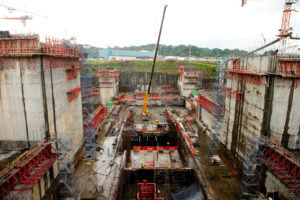Read in Chinese 中文版本
After several months of anticipation, the blueprints for China’s Belt and Road Initiative (BRI) finally include Latin America and the Caribbean (LAC). As speculation gives way to reality, it’s a good time to assess what we know about the BRI’s arrival and what it can offer Latin America.
Enter Latin America
Over the last couple of months, Chinese leaders have endeavoured to modify the Belt and Road discourse to include LAC, with noticeable success. Diplomats now consistently refer to the region as a “natural extension” of the Maritime Silk Road and an “indispensable participant” in the BRI’s construction. This language was first used by President Xi Jinping during his meeting with Argentina’s President Mauricio Macri on the sidelines of the 2017 Belt and Road Forum. It was also included in the Special Declaration on the Belt and Road. The Declaration, signed during the Second China-CELAC Ministerial Forum in January 2018, presents the BRI as “a new platform for mutually beneficial cooperation” between China and Latin America, and affirms that the former “invites Latin American and Caribbean countries to join.”
In addition to providing this open invitation to the region as a whole, China has also started formally incorporating individual LAC countries into the BRI through bilateral “Belt and Road Cooperation Agreements.” As of June 2018, four of the roughly 70 countries that have signed these agreements are located in the LAC region.
The first Latin American country to sign one was Panama, which established ties with China just last year. This was followed by Antigua and Barbuda, Trinidad and Tobago, and, most recently, Bolivia. Although the content of these agreements – much like the proverbial “roads” that would connect LAC to the rest of the BRI – remains unclear, their proliferation among Latin American countries confirms China’s desire to gradually incorporate the region into its colossal enterprise.
A Belt and Road by any other name
Ironically, the importance of “who is in” and “who is out” of the BRI may be overstated because China’s activities in Latin America have been Belt and Road-esque in substance, if not in style, for a while now.
The main thrust of the initiative – infrastructure financing and development – has been a fixture of China’s approach to Latin America for over a decade. Since 2005, China has extended roughly US$150 billion in state-to-state financing to LAC, around US$27 billion of which has gone toward infrastructure projects, including a road in Costa Rica, railways in Argentina, and a port in Trinidad and Tobago.
Even beyond state-to-state finance, a great number of other proposed projects, ranging from a port in Peru to an underwater fibre optic cable between China and Chile, echo the BRI’s mantra of connectivity.
Given these similarities, it is no wonder that critics claim that many of these projects (and to some extent the BRI itself) are just old wine in new bottles. Indeed, a number of Chinese projects throughout the world – such as the Seventh Bangladesh-China Friendship Bridge, which both parties agreed to in 2012 – are being retroactively rebranded to look like Belt and Road successes.
Latin America is no exception. Take the North-South link of Jamaica’s Highway 2000, for example, which is now being repackaged as a Belt and Road project, even though the Concession Agreement with China Harbour Engineering predates the BRI itself.
The Panama-Chiriquí Railway, which is currently undergoing a feasibility study, seems to be the only Belt and Road project in Latin America to date that did not start prior to the country’s participation in the initiative.
All (Belts and) Roads lead to China
For all of Beijing’s claims regarding the BRI’s transformative potential, there are few signs that the seemingly all-encompassing initiative registers in the region beyond a small sector of elites and China specialists. To these elites, the BRI presents an opportunity to develop their nation’s infrastructure, especially transport infrastructure, with hopes of long-term benefits in areas ranging from commerce to public health.
Taken at face value, the proposition to join the BRI is an easy sell because it promises much and demands little. Even if no substantial increase in infrastructure financing were to materialise, Chinese state support for the initiative could itself incentivise other Chinese actors to engage with Belt and Road countries. This alone is likely a convincing enough reason for Latin American countries to get on board.
However, as the Belt and Road paves its way across the region, Latin American leaders and policy makers would do well to examine the initiative with a critical eye. For starters, the socio-economic success of individual Belt and Road projects, like that of any undertaking, is not guaranteed. A rising chorus of voices is calling attention to the reality that, once deals are inked and the cameras put away, projects are free to blunder and underperform. This was the case before the Belt and Road, and it is still the case now. In Latin America specifically, Venezuela’s abortive Tinaco-Anaco railway is emblematic of just how badly and quickly a project can sour.
Moreover, even if the deals were to pan out as planned, the initiative’s success is not without drawbacks. Its emphasis on connectivity, for example, does not challenge the centrality of extractive industries and commodities to Sino-Latin American commercial relations.
Increased connectivity could also exacerbate the already asymmetrical relationship between Latin American countries – as comparatively small, individual commodities exporters – and China – as one massive commodities importer. This is to say nothing about fears regarding China’s desire to control every phase of the supply chain, and its increasingly large profile in the region’s critical sectors, including energy. Environmental concerns – a constant source of concern around Chinese engineering projects in Latin America – and concern over the rights of local communities (especially indigenous peoples) also remain.
China has opened the door for Latin America’s participation in the Belt and Road Initiative. What exactly lies beyond the door remains to be seen.
